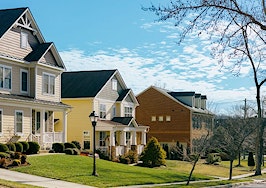In these times, double down — on your skills, on your knowledge, on you. Join us Aug. 8-10 at Inman Connect Las Vegas to lean into the shift and learn from the best. Get your ticket now for the best price.
Tawan Davis grew up in a rental home in Northeast Portland, now he’s CEO of a company that manages thousands of its own. And he’s scaling up through the downturn.
Specifically, the New York-based real estate investor is targeting single-family homes, both existing and newly built, for rent.
Davis started the Steinbridge Group in 2016. It now has $500 million in active investments, a number that could triple over the next 18 months. The company’s goal is to invest over $2 billion to build a portfolio that contains thousands of homes. Steinbridge already manages more than 3,000 units, company representatives said.
“The reality is very simple,” Davis, 45, told Inman in a recent interview. “You cannot address affordability in the United States and the housing crisis in the United States without including single-family homes.”
Steinbridge is building up momentum in the single-family rental market, given the market’s massive size and the opportunity to provide better rentals than the mom-and-pop owners who currently manage most rental homes, Davis said.
And at over $4 trillion, Davis called single-family rentals the largest asset class that can be invested in in the United States.
Here’s why he’s looking to triple his firm’s investment into single-family rentals, why Steinbridge is increasing its focus on single-family homes for rent, and how Davis says he’s helping to fill a growing need in real estate.

One of the Steinbridge Group’s single-family homes in Philadelphia. The firm plans to expand into the Sun Belt in the near future. Image courtesy of Tawan Davis
The $4 trillion opportunity
Institutional investors have gained attention for billion-dollar deals over the past two years.
Indeed, analysts expect major investor activity to remain above historical levels.
Davis spelled that out by looking at the size of the opportunity in the single-family rental market.
Among the estimated 84 million single-family homes in the U.S., 24 million are for rent. About 2 percent of those are owned by larger institutional investors, Davis said. That share is growing, but the opportunity is huge.
“By every measurement, whether it is by demand, whether it is by supply, whether it is by availability or economic value, the single-family home is the largest responder to the rental need in the United States,” Davis said. “It’s a meaningful part of the market that needs to be addressed.”
The majority of rental homes are owned by so-called “mom-and-pop” landlords, according to the National Association of Realtors. That creates an opportunity for well-financed investors to step in.
“A lot of the smaller landlords who own single family homes don’t often have the wherewithal, the knowhow, technology and capital to meaningfully operate in a high quality way,” Davis said. “My view is that [single-family rentals are] a meaningful part of any housing crisis response.”

The Steinbridge Group focuses on buying single-family homes in transitioning neighborhoods on the East Coast.
Balancing profits and housing affordability
Davis opened up about the fine line between providing housing that middle-income earners can afford while generating returns for investors.
“We are able to both provide affordability and make a meaningful return,” Davis said. “In fact, we make a strong return for our investors.”
Steinbridge is able to do that by focusing on the middle bracket of the rental market.
“Usually when we talk about providing homes for working and middle-income families, people think low-income housing,” Davis said. “It’s actually not our business…Our focus is working families.”
The median family income in 2021 was just under $70,000, according to the U.S. Census Bureau.
“That’s the backbone of the renter and of the homeowner population,” Davis said, “so that’s our target.”
Steinbridge targets neighborhoods that are already in transition, Davis said.
“We look at Census tracts from 2000, 2010, 2020 and forward, and we see the neighborhoods in transition and where rents are going up,” he said. “Even when the economy is bad, where are housing prices going up?”
Davis said focusing on acquiring, rehabbing and renting homes in those neighborhoods allows Steinbridge to keep people in their neighborhoods even as they gentrify and prices rise.
“We’re able to basically both build a bridge between the transition that’s happened, that’s happening in the neighborhoods and by providing people homes,” Davis said.
Focusing on neighborhoods in transition
By focusing on neighborhoods that are transitioning, Davis said, the firm can provide working class people homes to rent that otherwise might be run down or too expensive.
“We are looking at the change and saying, you know what? While it’s in flux, we’re going to provide residences for people who are already there so that they can stay put and experience the neighborhood change,” Davis said.
“All Americans deserve and want to live in nice neighborhoods, safe neighborhoods, neighborhoods where there are good schools and job opportunities,” Davis said.
At times, that approach can lead to criticism and backlash over gentrification, or the theory that investment in lower income neighborhoods will lead to higher home prices that eventually displaces the people who originally lived there.
“I don’t care how meaningful and how heartfelt the opposition to change is,” Davis said. “Property rights is preeminent in the U.S. Constitution. We cannot keep someone from selling their home and if someone inherited a home that they want to sell, then we can’t keep them from doing that,” he said. “But what we can do is we can make sure that as the neighborhood changes, we are part of building the bridge to that change.”
Steinbridge typically doesn’t place renters in homes if the price of rent is more than 30 percent of their income, above which is considered burdensome.
“We learn about our potential tenants,” Davis said. “And based on that, we basically determine whether the units that we are renting make sense for them.”
“You’re talking about teachers and nurses and firefighters and transit workers,” Davis said. “All of whom have stable good jobs, but who often don’t have enough savings or other structures to buy in their neighborhoods.”

Single-family built-for-rent housing is the newest real estate asset class. Institutional investors have capitalized on a growing desire by renters who want more space. Getty Images
A new focus on built-for-rent
Davis’ approach is another reason experts say large investors are becoming more interested in built-for-rent homes, sometimes working directly with homebuilders to produce entire neighborhoods of single-family rental homes.
“In the Northeast, we’re largely a rehab strategy,” Davis said. “In other parts of the country, we participate in building.”
Steinbridge has done built-for-rent in Texas and Virginia and is now looking to expand into Georgia and Florida, two of the most popular markets for built-for-rent investors.
“Our portfolio is probably 60 percent built-to-rent, around 40 percent [single-family rental] rehab today and growing,” Davis said.
Creating a pathway to ownership
Steinbridge is also working to create more opportunities for renters to eventually move on to buy homes, including through a new partnership with PNC Bank that started in May.
“Thirty percent of American families’ net worth is in their home,” Davis said. “So we help people walk the path of home ownership, and we do that right now with PNC.”
Steinbridge largely acts as a facilitator, introducing renters who indicate they want to buy a home to a Realtor partner and representatives at PNC.
“Many of the reasons why people don’t buy homes is because of I would say a lack of information,” Davis said.
The lender offers low down payment mortgages and provides down payment assistance to buyers.
“PNC leans forward with anywhere from $5,000 to $10,000 of down payment assistance,” Davis said. Philadelphia and Pennsylvania programs also provide their own down payment assistance on top of that.
“PNC waives certain fees that they would otherwise charge in transaction [and] they have eliminated the deposit requirement,” Davis said. “If all else fails, we also can help with some seller assistance to help people get into their first home.”
Get Inman’s Property Portfolio Newsletter delivered right to your inbox. A weekly roundup of news that real estate investors need to stay on top, delivered every Tuesday. Click here to subscribe.













